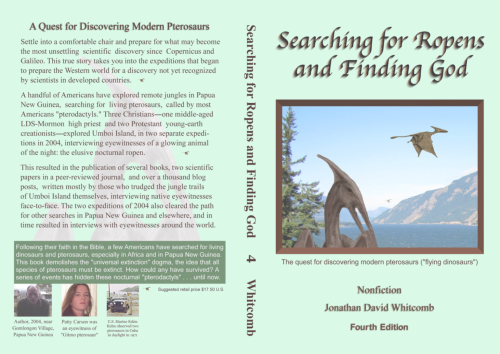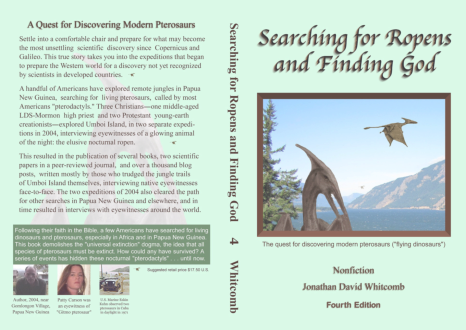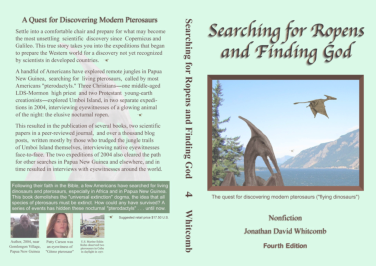
Live Pterosaurs in America compared with Searching for Ropens and Finding God
What some persons call “flying
dinosaurs” or “pterodactyls”
(third edition of this nonfiction)
copyright 2009-2019 Jonathan Whitcomb

Live Pterosaurs in America
Comparing two cryptozoology books

The quest for discovering
modern pterosaurs
(now in its fourth edition)
Both nonfiction books are by the cryptozoologist
Jonathan David Whitcomb, living-pterosaur expert
From the author: “Both nonfictions include the two sightings in Cuba,
encounters by Patty Carson (1965) and Eskin Kuhn (1971), both of
which were at Guantanamo Bay.
“Overlapping of information, in the two books, was unavoidable, in
regard to the two sightings in Cuba, yet the encounters are handled
in different ways, each book having its own unique coverage. I suggest
reading both books to learn about many sightings including those two
encounters in Cuba in the mid-twentieth century.
“Searching for Ropens and Finding God (SFRFG) has a 100-page
chapter on sightings in the United States, with many encounters
being absent from Live Pterosaurs in America. Likewise, LPA has
many reports not in SFRFG. These two paperbacks may go well
together on your book shelf, complementing each other”
How do these paperback cryptozoology books differ? SFRFG is a lot
longer and is a cross-genre: true-life adventure, cryptozoology, and
traditional Christian, although it actually has very limited references
to religion. LPA, on the other hand, is more strictly on cryptozoology.



Live Pterosaurs in America
Searching for Ropens and Finding God
“LPA” - third edition
154 pages
published in 2011
suggested $13.64
paperback
5.5 by 8.5 inches
ISBN-13: 978-1466292116
About living pterosaurs
in the United States
“SFRFG” - fourth edition
360 pages
published in 2014
suggested $17.50
paperback
6 by 9 inches
ISBN-13: 978-1502865526
About living pterosaurs
worldwide (incl. in USA)


Quoting from these two cryptozoology books on eyewitness reports of modern living pterosaurs
“At about the time the physicist was analyzing those two lights, an expedition
team called Destination Truth (for the Sci-Fi channel) videotaped a flying light
similar to what Paul had videotaped. It was flying near the coast of the main-
land of Papua New Guinea. The video footage was analyzed, in the United
States, by two forensic video experts; they could not explain the light. Natives
on that east coast of the mainland of Papua New Guinea had told the explorers
that the lights are made by large flying creatures.” [page 6 of the third edition
of Live Pterosaurs in America]
“But what makes bioluminescence important to the concept of pterosaurs
living in the United States? Bioluminescence helps ropens fly at night, and a
nocturnal ropen in the United States should rarely appear in daylight, thus
revealing a pterosaur-form only rarely.” [page 68]
“The British biologist Evelyn Cheesman, earlier in the twentieth century, gave her
readers insight by writing about her observations. She long ago gave up trying to
explain the strange flying lights in New Guinea, but now we know. Thank you to
Richard Muirhead, whose research led to her report in an old book.
“Eyewitness testimonies of natives, Australians, and the American veteran Duane
Hodgkinson gave us priceless evidence. Reports from other areas of the world later
supported our strange theory of modern living pterosaurs, including reported
sightings in England, Spain, the Netherlands, various parts of Africa, Singapore, the
Philippines, and other countries, from persons of various cultures and beliefs.”
[from page 6 of the nonfiction book Searching for Ropens and Finding God]
ver-11

Live Pterosaurs in America
Comparing two cryptozoology books
Live Pterosaurs in America compared with
Searching for Ropens and Finding God
What some persons call “flying
dinosaurs” or “pterodactyls”
(third edition of this nonfiction)

The quest for discovering
modern pterosaurs
(now in its fourth edition)

Both nonfiction books are by the cryptozoologist
Jonathan David Whitcomb, living-pterosaur expert
From the author: “Both nonfictions include the two sightings in Cuba, encounters by Patty
Carson (1965) and Eskin Kuhn (1971), both of which were at Guantanamo Bay.
“Overlapping of information, in the two books, was unavoidable, in regard to the two sightings
in Cuba, yet the encounters are handled in different ways, each book having its own unique
coverage. I suggest reading both books to learn about many sightings including those two
encounters in Cuba in the mid-twentieth century.
“Searching for Ropens and Finding God (SFRFG) has a 100-page chapter on sightings in
the United States, with many encounters being absent from Live Pterosaurs in America.
Likewise, LPA has many reports not in SFRFG. These two paperbacks may go well together
on your book shelf, complementing each other”
How do these paperback cryptozoology books differ? SFRFG is a lot longer and is a cross-
genre: true-life adventure, cryptozoology, and traditional Christian, although it actually has
very limited references to religion. LPA, on the other hand, is more strictly on cryptozoology.


Live Pterosaurs in America
Searching for Ropens and Finding God
“LPA” - third edition
154 pages
published in 2011
suggested $13.64
paperback
5.5 by 8.5 inches
ISBN-13: 978-1466292116
About living pterosaurs
in the United States
“SFRFG” - fourth edition
360 pages
published in 2014
suggested $17.50
paperback
6 by 9 inches
ISBN-13: 978-1502865526
About living pterosaurs
worldwide (incl. in USA)


Quoting from these two cryptozoology books on eyewitness
reports of modern living pterosaurs
“At about the time the physicist was analyzing those two lights, an expedition
team called Destination Truth (for the Sci-Fi channel) videotaped a flying light
similar to what Paul had videotaped. It was flying near the coast of the main-
land of Papua New Guinea. The video footage was analyzed, in the United
States, by two forensic video experts; they could not explain the light. Natives
on that east coast of the mainland of Papua New Guinea had told the explorers
that the lights are made by large flying creatures.” [page 6 of the third edition
of Live Pterosaurs in America]
“But what makes bioluminescence important to the concept of pterosaurs
living in the United States? Bioluminescence helps ropens fly at night, and a
nocturnal ropen in the United States should rarely appear in daylight, thus
revealing a pterosaur-form only rarely.” [page 68]
“The British biologist Evelyn Cheesman, earlier in the twentieth century, gave her
readers insight by writing about her observations. She long ago gave up trying to
explain the strange flying lights in New Guinea, but now we know. Thank you to
Richard Muirhead, whose research led to her report in an old book.
“Eyewitness testimonies of natives, Australians, and the American veteran Duane
Hodgkinson gave us priceless evidence. Reports from other areas of the world later
supported our strange theory of modern living pterosaurs, including reported
sightings in England, Spain, the Netherlands, various parts of Africa, Singapore,
the Philippines, and other countries, from persons of various cultures and beliefs.”
[from page 6 of the nonfiction book Searching for Ropens and Finding God]
copyright 2009-2019 Jonathan Whitcomb
ver-11

Live Pterosaurs in America
Comparing two
cryptozoology books
Live Pterosaurs in America compared with
Searching for Ropens and Finding God
What some persons call “flying
dinosaurs” or “pterodactyls”
(third edition of this nonfiction)

The quest for discovering
modern pterosaurs
(now in its fourth edition)

Both nonfiction books are by the cryptozoologist
Jonathan David Whitcomb, living-pterosaur expert
From the author: “Both nonfictions include the two sightings
in Cuba, encounters by Patty Carson (1965) and Eskin Kuhn
(1971), both of which were at Guantanamo Bay.
“Overlapping of information, in the two books, was unavoidable,
in regard to the two sightings in Cuba, yet the encounters are
handled in different ways, each book having its own unique
coverage. I suggest reading both books to learn about many
sightings including those two encounters in Cuba in the mid-
twentieth century.
“Searching for Ropens and Finding God (SFRFG) has a 100-
page chapter on sightings in the United States, with many
encounters being absent from Live Pterosaurs in America.
Likewise, LPA has many reports not in SFRFG. These two
paperbacks may go well together on your book shelf, com-
plementing each other”
How do these paperback cryptozoology books differ? SFRFG
is a lot longer and is a cross-genre: true-life adventure, crypto-
zoology, and traditional Christian, although it actually has
very limited references to religion. LPA, on the other hand,
is more strictly on cryptozoology.


Live Pterosaurs in America
Searching for Ropens and
Finding God (4th edition)
“LPA” - third edition
154 pages
published in 2011
suggested $13.64
paperback
5.5 by 8.5 inches
ISBN-13: 978-1466292116
About living pterosaurs
in the United States
“SFRFG” - fourth edition
360 pages
published in 2014
suggested $17.50
paperback
6 by 9 inches
ISBN-13: 978-1502865526
About living pterosaurs
worldwide (incl. in USA)
Quoting from these two cryptozoology books on
eyewitness reports of modern living pterosaurs

“At about the time the physicist was analyzing those two lights,
an expedition team called Destination Truth (for the Sci-Fi
channel) videotaped a flying light similar to what Paul had
videotaped. It was flying near the coast of the mainland of
Papua New Guinea. The video footage was analyzed, in the
United States, by two forensic video experts; they could not
explain the light. Natives on that east coast of the mainland
of Papua New Guinea had told the explorers that the lights
are made by large flying creatures.” [page 6 of the 3rd edition
of Live Pterosaurs in America]
“But what makes bioluminescence important to the concept
of pterosaurs living in the United States? Bioluminescence
helps ropens fly at night, and a nocturnal ropen in the United
States should rarely appear in daylight, thus revealing a
pterosaur-form only rarely.” [page 68]

“The British biologist Evelyn Cheesman, earlier in the twentieth
century, gave her readers insight by writing about her observa-
tions. She long ago gave up trying to explain the strange flying
lights in New Guinea, but now we know. Thank you to Richard
Muirhead, whose research led to her report in an old book.
“Eyewitness testimonies of natives, Australians, and the
American veteran Duane Hodgkinson gave us priceless evi-
dence. Reports from other areas of the world later supported
our strange theory of modern living pterosaurs, including
reported sightings in England, Spain, the Netherlands, various
parts of Africa, Singapore, the Philippines, and other countries,
from persons of various cultures and beliefs.” [from page 6 of
the nonfiction book Searching for Ropens and Finding God]
copyright 2009-2019 Jonathan Whitcomb
ver-11